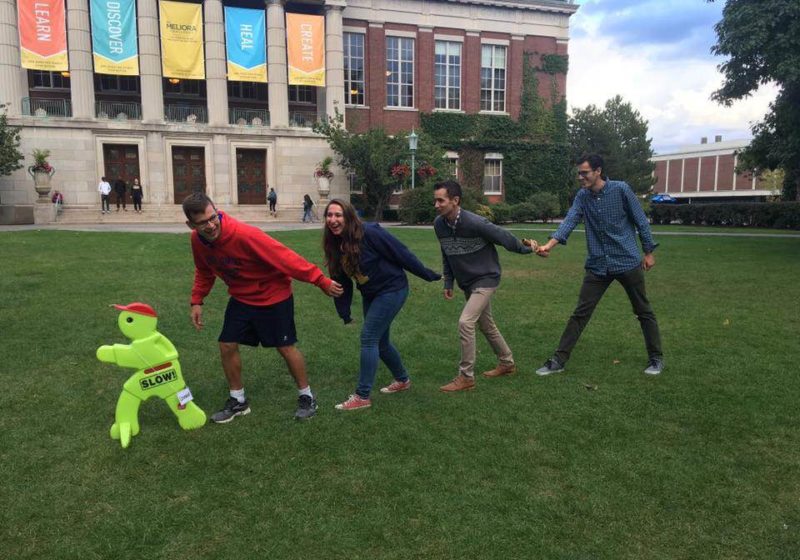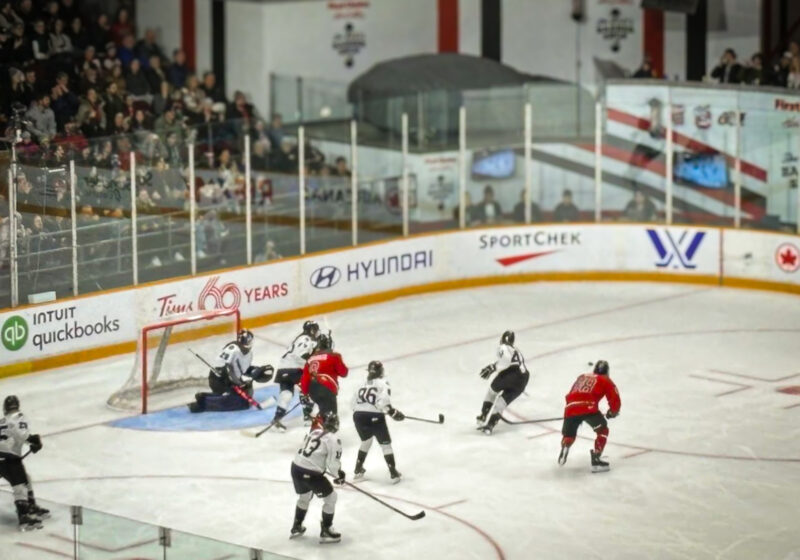It’s 42 degrees, windy, and dark. Inside the lobby of the Goergen Athletic Center, a small group of brightly dressed students gathers promptly at 5 p.m.
Junior John Cole, the run leader for the day, paces restlessly.
“We’ll wait an extra three minutes before starting the run in case anyone else shows,” he says.
URunning—of which Cole and his group are a part—holds runs six days a week, with morning and afternoon shifts and designated routes and run leaders for each day.
The runners that evening circle up and greet each other routinely. There are three new faces today, and Cole has everyone introduce themselves before heading out.
At exactly 5:03 p.m., they leave the warm lobby and jog out into the cold November night.
“The route today is Southside Short,” Cole says, dropping back to explain the route to the three new runners. “It’s about three miles, and we’ll all meet back up in front of the GAC at the end of the run.”
By the time he’s explained the route, the six regular runners in the group have started to disappear in the distance. As the route leader, Cole tries to keep track of all the runners, but the difference in pace between the regular runners and new members is a challenge he often faces.
“Pace is definitely an issue we’ve been working to resolve,” Cole says. “There’s a lot more of a focus on it this year than in past years, but there’s not an easy solution for it.”
Junior Ramel Morales chimes in: “We plan on getting new members jet packs so they can keep up.”
At the beginning of the year, the club’s executive board tried to implement different pace groups for the runs, but there weren’t enough runners in the slow group to keep it going.
“What we really need is more casual membership so that we have more people who are willing to run at that nine to ten minute pace,” says junior Greg Marshall, the group’s president, in a later interview. “Then we’d be able to establish those pace groups.”
After finishing the run that night, the group gathers outside the GAC and begins talking about routes as if they were recipes, discussing possible new segments and adaptations that could be made to their typical paths.
“The graveyard run is a great run, because there are so many different trails,” Cole says. “You can have a lot of that variation in that route, so it never gets old.”
The conversation quickly breaks down into a debate over the best route the club takes.
“I know what’s not the best route: the suspension bridge run,” junior Isaac Mosebrook says. “It’s too simple—out and back along the river—and it’s always so windy.”
“No way, I love that run,” freshman Tanner Metcalfe replies. “There’s a great view of the river for the whole route.”
URunning has about twenty different routes its members run.
“We try to mix it up and keep it interesting,” sophomore Haley Wohlever says. “No one wants to run the same loop every single day.”
Monday through Thursday, the route mileage each day usually falls between three to five miles. Long runs of seven miles or more are on Saturdays. Fridays are always “fun run” practices, which could be anything from running in a local park to playing capture the flag in Fauver stadium.
“Running club could be really simple, where we just send a small group out for one run a day and the pace and route is completely up to them,” Marshall says. “But there are a lot of different ways for people to get involved in running—different routes, races, workouts, and experiences that people aren’t always aware of when they first get involved with the club. We try to provide as many of those opportunities as possible.”
“We are kind-of in the gray area between a club sport and an organization,” junior Jeremy Deniega says. “We do have practices every week, but members can come as often as they want and we do not have a coach. Races are also optional.”
Outside of planning the routes and run leaders for each week, the e-board keeps track of upcoming race opportunities for members to get involved in and spends a lot of time keeping track of bib numbers, race times, transportation, and event fees.
A lot of time also goes into race organization and the details always change depending on the specific race.
“This weekend, we ran at a professionally-organized race, so our members had to register independently and pay the fee out-of-pocket,” Marshall says. “But we reimbursed members with a portion of that fee at a club discount.”
Transportation has been the biggest challenge for race organization this semester.
“While we are participating in many off-campus races, transportation is limited since not many members have cars,” Deniega says.
Less work goes into UR-affiliated races, since the club can cover the registration fees, and transportation is not an issue. URunning also organizes a bi-annual 5K against RIT’s running club that takes a lot less organization, since members participate for free.
“One idea we’re looking into is adding a track component to our club—give people the opportunity to race some shorter distances as well,” Wohlever says.
Although many athletes practice running on their own, running in a group has a lot of advantages.
“Waking up in the morning or going to practice in the afternoon, knowing that there are fellow members ready to run gives me extra motivation to run that day,” Deniega says.
Junior Emily Volk always ends up running faster and feeling stronger when working with a group.
“I joined because I ran cross-country in high school and wanted to continue running in a group, but in a slightly less competitive and less time-consuming way,” she says.
“Running as a group makes it less painful and more enjoyable. We all motivate each other,” junior Ramel Morales adds. “Plus, running alone is lonely and too quiet.”
The highlight of the club’s semester so far was decidedly the Dirt Cheap Stage Race that took place this past weekend at Mendon Ponds Park in Rochester.
The race consisted of a three-mile trail race in the dark on Friday night, a 5.5-mile trail race on Saturday morning, and an 11-mile trail run on Sunday morning.
“It’s pretty incredible that we had so many members come out for such an insane race,” Wohlever says.
“Through all three days of three, five, and 11 miles, we gave each other unwavering support to conquer every hill and push through all the pain,” Deniega says.
Though all races have been completed for the fall season, URunning will continue to hold runs through the end of the semester.
“From what I’ve seen, even over the past year, the number of people and dedication to the sport has increased,” Wohlever says. “We have a lot more people interested and motivated to go farther and faster.”
“Whether you want to run a mile or want to run an Iron Man, whether you’re working out to stay in shape or working up to complete a marathon, come out and run,” Marshall says. “We support all speeds and all distances.”



